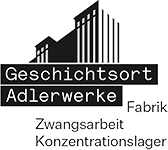> Adlerwerke Historical Site (Foyer)
> Foreign workers
> Ausländische Arbeitskräfte
> The forced labour system
> System Zwangsarbeit
> The concentration camp in the factory
> Das Konzentrationslager in der Fabrik
> Clearance and death march
> Räumung und Todesmarsch
> Legal proceedings
> Juristische Aufarbeitung
> After 45
> Nach 45
> Theme boxes
> Themenboxen
> Gallus – A changing community
> Gallus – ein Stadtteil im Wandel
Gallus
A changing community
A changing community
The name “Gallus” has its origins in the gallows once set up outside the city gates in the west of Frankfurt. The district evolved from 1884 onwards along the newly constructed railway line. Factories were established outside the town limits and needed manpower. The latter came from the surrounding regions. Housing, schools, churches, shops, and inns sprouted up to serve them. Since 1895, a tram line has connected the Gallus district with the city centre. The City of Frankfurt had the Hellerhof housing estate built between 1901 and 1936. It provided affordable housing for low-income persons.
Many of the Gallus district’s residential buildings and industrial operations were destroyed during World War II. After that, fewer people lived in the district than before. The factories gradually converted their production or shut down altogether. Service companies, administrative offices, and the media moved into the old buildings or constructed new ones. The residents’ occupational skills no longer corresponded to the available jobs. Unemployment and crime increased.
Around the year 2000, Gallus ranked as a deprived area. The city subsidized the district between 2001 and 2016. Municipal administration offices moved there. The transformation of the Gallus district continued. A new quarter—the “Europaviertel”—was built on the grounds of the former freight yard. It is an expensive residential area. New residents shape the community, but they work in offices and not in industrial production like the inhabitants of Gallus a hundred years ago.

The Galluswarte, 2022
Photo: Thomas Altmeyer
Kamerun
“Kamerun” (German for Cameroon) – Isn’t that a country in Africa? But people have been calling the Gallus “Kamerun” for more than a hundred years. There are two explanations, both of which are indirectly racist in nature.
Explanation 1: After World War I, France occupied western Germany. Black French soldiers were stationed near Frankfurt—an unusual experience for white Germans.
Explanation 2: Smoke from the factory smokestacks and the railway coloured people’s clothing black and the workers came home from the factories with faces blackened by oil and soot. It was a racist notion to equate them with people from Africa.
What is more, these explanations cannot possibly be correct. There are spoken and written references to the “Kamerun” district dating all the way back to 1902. At that time, there were no bleach greens where smoke could have dirtied the laundry. Nor was there any heavy industry in Gallus, but above all mechanical and electrical engineering companies like the Adlerwerke. The workers washed in a washroom before leaving the factory after work. There were no Black soldiers stationed in the district. Germany had colonies in Africa, but Gallus had no Blacks.
In the early twentieth century, Gallus was planned as a “settlement outside the city to the southwest”. Newly emerging districts outside the city centers often referred to as “colonies”. In general, this was a term used for places outside the familiar sphere. At the time, Germany ruled over and exploited Cameroon as a colony. The name is accordingly reminiscent of German colonialism.
Migration
The Gallus district evolved as a result of migration. The first inhabitants came from villages in the regions around Frankfurt. They were looking for work in the factories and companies that sprouted up in Gallus in the early nineteenth century.
During World War II the Nazi government brought prisoners of war and foreign civilian workers to Frankfurt. Several of the camps used to house them were in Gallus. And it was there that the Katzbach concentration camp was set up in the Adlerwerke.
Starting in the 1960s, “guest workers” came to the district from Southern Europe and Turkey. They had been recruited to serve as manpower; the intention was that they would soon return to their home countries. However, many of them became Frankfurters. They worked alongside Germans in the factories. It would be years before they were able to bring their families to Frankfurt as well. The immigrants founded associations and religious communities.
After 1989, so-called “late resettlers” – ethnic German repatriates – from Eastern Europe followed. People from Africa, Asia, and Latin America often came to the district as refugees. The population of Gallus now represents approximately 140 different nationalities.

